microbio 2125 unit 5 (part 20) plague
1/12
There's no tags or description
Looks like no tags are added yet.
Name | Mastery | Learn | Test | Matching | Spaced |
|---|
No study sessions yet.
13 Terms
etiological agent
Yersinia pestis
Distinguishing characteristics of etiological agent:
Gram-negative rod
Unusual bipolar staining
Capsules

Virulence Factor(s):
Capsular and envelope proteins (protect against phagocytosis, foster intracellular growth)
Coagulase
Endotoxin
Murine toxin
Predisposing Factors:
Contact with wild or domestic animals
Flea bites
Exposure to infected humans
Transmission:
Flea vectors (blocked esophagus from coagulase, ravenous biting causing fleas to eat more even if full)
Wild animals (sylvatic plague)
Domestic animals (urban plague)
Human-to-human (pneumonic form)
Syndrome (signs + symptoms): Bubonic plague
necrosis, swelling of lymph nodes (bubo) in groin or axilla (armpit), Incubation period lasts 2 – 8 days ends in fever, chills, headache, nausea, weakness
Syndrome (signs + symptoms):Septicemic plague
intravascular coagulation, subcutaneous hemorrhage, purpura (black plague)
Syndrome (signs + symptoms): Pneumonic plague
lung infection, highly contagious, fatal if untreated
Affected body region/system:
Lymphatic system (bubonic)
Bloodstream (septicemic)
Lungs (pneumonic)
Treatment:
Streptomycin, tetracycline, or chloramphenicol
Treated plague has 90–95% survival rate
Prevention:
Killed or attenuated vaccine for at-risk individuals
Quarantine infected individuals
Control rodent and flea populations near human habitats
Other notes:
ID = 3–50 bacilli
Death can occur 2–4 days after symptom appearance if untreated
Bacteria spread to amplifying hosts through flea vectors
Diagnosis:
Imperative as death may occur 2 – 4 days after appearance of symptoms
Depends on travel & exposure history, symptoms, and lab findings from aspiration of buboes